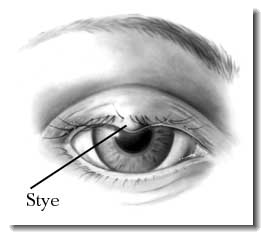
Stye And Chalazion: What is it?
Symptoms You May Experience:
Examination: What Your Eye Doctor Will Look For:
What You Can Do:
When To Call Your M.D.:
Treatment:
Prognosis: Will I See Better?
A stye, or hordeolum, is a nodule of inflammation that forms a bump in the eyelid and is associated with a bacterial infection. A stye usually begins to form when an oil gland in the eyelid margin becomes clogged. A pocket of bacterial infection, or an abscess, then develops in the clogged oil gland. Very rarely, the infection can spread from the eyelid to other parts of the face. Persons with blepharitis are especially prone to developing styes.
In contrast to a stye, a chalazion is a nodule of inflammation that forms a bump in the eyelid without associated infection. Chalazia tend to be present longer than styes, and they are usually less tender and red. Some styes develop into chalazia after the body clears the infection but not the inflammation.
In contrast to a stye, a chalazion is a nodule of inflammation that forms a bump in the eyelid without associated infection. Chalazia tend to be present longer than styes, and they are usually less tender and red. Some styes develop into chalazia after the body clears the infection but not the inflammation.
With a stye, you will notice a bump in your eye lid that develops over several days. The bump is usually tender and red. With a chalazion, the bump that forms in your eyelid will often take longer to form. It is usually only slightly tender to the touch and is less red than a stye. Your vision may be slightly blurred if the chalazion presses on your eyeball, causing astigmatism (an irregular curvature of the cornea).
Your eye doctor will examine your eyelids to determine if a stye or chalazion is present. He or she may flip your upper eyelids inside out to see if the stye or chalazion is on the inside surface of the eyelid. He or she may also examine your eyelid margins with a slit lamp to see if blepharitis, which may have caused the stye or chalazion to form, is present.
If you have blepharitis, perform regular lid hygiene with warm compresses and lid scrubs to control the blepharitis and reduce your chance of developing a stye or chalazion. If a stye or chalazion does form, using warm compresses several times a day may help it to heal faster. To make a warm compress, wet a washcloth with warm water, wring out the excess, and place the cloth over your closed eye lids for a least five minutes.
If you have a stye or chalazion that does not improve after several days of warm compresses or becomes very large and bothersome, call your ophthalmologist. If the redness and swelling spread beyond the eyelid or if you develop a fever, call your ophthalmologist immediately. If you have chalazia that keep reoccurring, see your eye doctor, because some rare serious eye diseases can present in this way.
If a stye is very large or does not improve with frequent warm compresses, your ophthalmologist may cut it open to let the contents drain out. Chalazia that have been present for several weeks or months are slower to improve on their own and can also benefit from surgical drainage. Antibiotics alone are generally not helpful for styes or chalazia, unless the infection spreads to other parts of the face. Drainage of a stye or chalazion is done in the office after local numbing medication is injected into the eyelid. Over the next several days, your ophthalmologist may prescribe an antibiotic ointment while the stye or chalazion continues to heal.
Most styes heal over several days on their own without requiring surgical drainage, and frequent warm compresses can speed this healing. Some chalazia also heal on their own, but others are slower to improve without being cut open and drained. Whether the stye or chalazion heals on its own or with surgical drainage, the eye lid generally heals well afterward with little or no scarring.

Above: A Typical Stye Eye Infection.
Contact Lenses | Glaucoma | Just For Fun | Eyeglasses | Eye Doctor | Eye Care And Symptoms | Eye Anatomy | Online Eye Tests | Laser Eye Surgery | Laser Eye Surgery Directory: Canada | Laser Eye Surgery Directory: USA | Laser Eye Surgery Reviews | Submit A Review | Contact Us | Privacy Policy | Sitemap
Copyright 2006-2009 Vision Health

